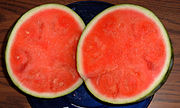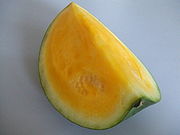Watermelon (Citrullus lanatus (Thunb.) Matsum & Nakai, family Cucurbitaceae) refers to both fruit and plant of a vine-like (climber and trailer) herb originally from southern Africa and one of the most common types of melon. This flowering plant produces a special type of fruit known by botanists as a pepo, which has a thick rind (exocarp) and fleshy center (mesocarp and endocarp); pepos are derived from an inferior ovary and are characteristic of the Cucurbitaceae. The watermelon fruit, loosely considered a type of melon (although not in the genus Cucumis), has a smooth exterior rind (green and yellow) and a juicy, sweet, usually red, but sometimes orange, yellow, or pink interior flesh.
History
David Livingstone, an explorer of Africa, described watermelon as abundant in the Kalahari desert, where it is believed to have originated. There, the ancestral melon grows wild and is known as the Tsamma melon (Citrullus lanatus var tastius).[citation needed] It is also known in Zimbabwe as 'nwiwa, mwiwa or iswe'. The plant has pinnatifid leaves. The flesh is similar to the rind of a watermelon and is often known as citron melon (distinct from the actual citron, of the citrus family); it is used for making jam and other preserves, and has a high content of pectin.[citation needed] It has established itself in the wild in Baja California.[citation needed]
It is not known when the plant was first cultivated, but Zohary and Hopf note evidence of its cultivation in the Nile Valley from at least as early as the second millennium BC. Finds of the characteristically large seed are reported in Twelfth dynasty sites; numerous watermelon seeds were recovered from the tomb of Pharaoh Tutankhamun,[1] although the existence of the fruit in ancient Egypt is not certain because it is not depicted in any hieroglyphic text nor does any ancient writer mention it. It wasn't present in any other culture of the ancient Mediterranean. By the 10th century AD, watermelons were being cultivated in China, which is today the world's single largest watermelon producer. By the 13th century, Moorish invaders had introduced the fruit to Europe; and, according to John Mariani's The Dictionary of American Food and Drink, "watermelon" made its first appearance in an English dictionary in 1615.
In Vietnam, legend holds that watermelon was discovered in Vietnam long before it reached China, in the era of the Hùng Kings. According to legend, watermelon was discovered by Prince Mai An Tiêm, an adopted son of the 11th Hùng King. When he was exiled unjustly to an island, he was told that if he could survive for six months, he would be allowed to return. When he prayed for guidance, a bird flew past and dropped a seed. He cultivated the seed and called its fruit "dưa tây" or western melon, because the birds who ate it flew from the west. When the Chinese took over Vietnam in about 110 BC, they called the melons "dưa hảo" (good melon) or "dưa hấu", "dưa Tây", "dưa hảo", "dưa hấu"—all words for "watermelon". An Tiêm's island is now a peninsula in the suburban district of Nga Sơn.[2][3]
Museums Online South Africa list watermelons as having been introduced to North American Indians in the 1500s. Early French explorers found Native Americans cultivating the fruit in the Mississippi Valley. Many sources list the watermelon as being introduced in Massachusetts as early as 1629. Southern food historian John Egerton has said he believes African slaves helped introduce the watermelon to the United States. Texas Agricultural Extension horticulturalist Jerry Parsons lists African slaves and European colonists as having distributed watermelons to many areas of the world. Parsons also mentions the crop being farmed by Native Americans in Florida (by 1664) and the Colorado River area (by 1799). Other early watermelon sightings include the Midwestern states (1673), Connecticut (1747), and the Illiana region (1822).
Charles Fredric Andrus, a horticulturist at the USDA Vegetable Breeding Laboratory in Charleston, South Carolina, set out to produce a disease-resistant and wilt-resistant watermelon. The result was "that gray melon from Charleston." Its oblong shape and hard rind made it easy to stack and ship. Its adaptability meant it could be grown over a wide geographical area. It produced high yields and was resistant to the most serious watermelon diseases: anthracnose and fusarium wilt. Today, farmers in approximately 44 states in the U.S. grow watermelon commercially, and almost all these varieties have some Charleston Gray in their lineage. Georgia, Florida, Texas, California and Arizona are the USA's largest watermelon producers.
This now-common watermelon is often large enough that groceries often sell half or quarter melons. There are also some smaller, spherical varieties of watermelon, both red- and yellow-fleshed, sometimes called "icebox melons."
Culture

For commercial plantings, one beehive per acre (over 9,000 m² per hive) is the minimum recommendation by the US Department of Agriculture for pollination of conventional, seeded varieties. Because seedless hybrids have sterile pollen, pollinizer rows of varieties with viable pollen must also be planted. Since the supply of viable pollen is reduced and pollination is much more critical in producing the seedless variety, the recommended number of hives per acre, or pollinator density, increases to three hives per acre (1,300 m² per hive).
In Japan, farmers of the Zentsuji region found a way to grow cubic watermelons, by growing the fruits in glass boxes and letting them naturally assume the shape of the receptacle.[4] The square shape is designed to make the melons easier to stack and store, but the square watermelons are often more than double the price of normal ones. Pyramid shaped watermelons have also been developed.
Seedless watermelons
Although so-called "seedless" watermelons have far fewer seeds than the seeded varieties, they generally contain at least a few soft, pale seeds. They are the product of crossing a female tetraploid plant (itself the product of genetic manipulation, using colchicine) with diploid pollen. The resulting triploid plant is sterile, but will produce the seedless fruit if pollenized by a diploid plant. For this reason, commercially available seedless watermelon seeds actually contain two varieties of seeds; that of the triploid seedless plant itself (recognizable because the seed is larger), and the diploid plant which is needed to pollenize the triploid. Unless both plant types are grown in the same vicinity, no seedless fruit will result.
Nutrition
| Watermelon, raw (edible parts) Nutritional value per 100 g (3.5 oz) | ||||||||||||||||||||||||||||||||||||||||
|---|---|---|---|---|---|---|---|---|---|---|---|---|---|---|---|---|---|---|---|---|---|---|---|---|---|---|---|---|---|---|---|---|---|---|---|---|---|---|---|---|
| Energy 30 kcal 130 kJ | ||||||||||||||||||||||||||||||||||||||||
| ||||||||||||||||||||||||||||||||||||||||
| Percentages are relative to US recommendations for adults. Source: USDA Nutrient database | ||||||||||||||||||||||||||||||||||||||||
Fresh watermelon may be eaten in a variety of ways and is also often used to flavor summer drinks and smoothies.
Watermelon contains about six percent sugar by weight, the rest being mostly water. As with many other fruits, it is a source of vitamin C. It is not a significant source of other vitamins and minerals unless one eats several kilograms per day.
The amino acid citrulline was first extracted from watermelon and analysed. [5] Watermelons contain a significant amount of citrulline and after consumption of several kg an elevated concentration is measured in the blood plasma, this could be mistaken for citrullinaemia or other urea cycle disorder.[6]
Watermelon rinds are also edible, and sometimes used as a vegetable. In China, they are stir-fried, stewed, or more often pickled. When stir-fried, the de-skinned and de-fruited rind is cooked with olive oil, garlic, chili peppers, scallions, sugar and rum. Pickled watermelon rind is also commonly consumed in the Southern US, [7] Russia, Ukraine, Romania and Bulgaria.[citation needed] In Balkans, specially Serbia, watermelon slatko is also popular [8].
Watermelon seeds are rich in fat and protein,[citation needed] and are widely eaten as a snack, added to other dishes, or used as an oilseed. Specialized varieties are grown which have little watery flesh but concentrate their energy into seed production. In China watermelon seeds are one of the most common snack foods, competing with sunflower seeds, and sold roasted and seasoned.[citation needed] In West Africa, they are pressed for oil, and are popular in egusi soup and other dishes.[citation needed] There can be some confusion between seed-specialized watermelon varieties and the colocynth, a closely-related species with which they share many characteristics, uses, and similar or identical names.
Watermelon is 92 percent water by weight.[9]
Watermelon is also mildly diuretic.
Watermelon with red flesh is a significant source of lycopene.
A traditional food plant in Africa, this fruit has potential to improve nutrition, boost food security, foster rural development and support sustainable landcare.[10]
Some people also prepare and eat watermelon peel (i.e., rind).[11]
Varieties
There are more than twelve hundred [12] varieties of watermelon ranging in size from less than a pound, to more than two hundred pounds with flesh that is red, orange, yellow, or white.[13] Several notable varieties are included here.
- Carolina Cross: This variety of watermelon produced the current world record watermelon weighing 262 pounds. It has green skin, red flesh and commonly produces fruit between 65 and 150 pounds. It takes about 90 days from planting to harvest. [14]
- Yellow Crimson Watermelon: variety of watermelon that has a yellow colored flesh. This particular type of watermelon has been described as "sweeter" and more "honey" flavored than the more popular red flesh watermelon.[15]
- Orangeglo: This variety has a very sweet orange pulp, and is a large oblong fruit weighing 9-14kg (20-30 pounds). It has a light green rind with jagged dark green stripes. It takes about 90-100 days from planting to harvest.[16]
- The Moon and Stars variety of watermelon has been around since 1926.[17] The rind is purple/black and has many small yellow circles (stars) and one or two large yellow circles (moon). The melon weighs 9-23kg (20-50 pounds).[18] The flesh is pink or red and has brown seeds. The foliage is also spotted. The time from planting to harvest is about 90 days.[19]
- Cream of Saskatchewan: This variety consists of small round fruits, around 25cm (10 inches) in diameter. It has a quite thin, light green with dark green striped rind, with sweet white flesh and black seeds. It can grow well in cool climates. It was originally brought to Saskatchewan, Canada by Russian immigrants. These melons take 80-85 days from planting to harvest.[20]
- Melitopolski: This variety has small round fruits roughly 28-30cm (11-12 inches) in diameter. It is an early ripening variety that originated from the Volga River region of Russia, an area known for cultivation of watermelons. The Melitopolski watermelons are seen piled high by vendors in Moscow in summer. This variety takes around 95 days from planting to harvest.[21]








Tidak ada komentar:
Posting Komentar